
I’ll never forget the night I settled in to watch the State of Origin, only to find my IPTV streaming perfectly with crystal-clear video but absolutely no sound. After years of helping mates and family troubleshoot their streaming setups across Sydney, Melbourne, and Perth, I’ve come to realize that IPTV audio problems in Australia are more common than most people think—and surprisingly, they’re usually fixable within minutes.
The frustration of dealing with an IPTV no sound issue is real. You’ve paid for your service, you’re ready to watch your favorite show or the footy, and suddenly you’re staring at a silent screen. Whether you’re streaming through a smart TV in Brisbane, an Android box in Adelaide, or a Firestick in Hobart, audio issues can strike anyone at any time.
What I’ve learned through countless troubleshooting sessions is that IPTV sound troubleshooting doesn’t require a degree in IT. Most audio problems stem from a handful of common causes, and once you understand what’s happening behind the scenes, you can fix IPTV audio issues faster than you can say “turn it off and on again” (though that actually works more often than you’d think).
In this comprehensive guide, I’m sharing everything I’ve learned about tackling IPTV audio problems in Australia. We’ll walk through the most common scenarios, explore device-specific solutions, and cover advanced fixes that even some technicians don’t know about. Whether you’re a complete beginner or someone who’s comfortable tinkering with settings, you’ll find practical solutions that actually work.
Understanding IPTV Audio Problems in Australia: Why They Happen
Before we dive into solutions, it helps to understand why IPTV audio problems occur in the first place. Unlike traditional broadcast television, IPTV streams both video and audio as separate data packets over your internet connection. This means there are multiple points where things can go wrong.
The most common causes I’ve encountered include:
Audio codec incompatibility – Your device doesn’t support the audio format being streamed. This is particularly common with older smart TVs that can’t handle newer audio codecs like AC3, EAC3, or DTS.
HDMI connection issues – Loose cables, incorrect HDMI settings, or faulty HDMI ports can disrupt the audio signal while video continues working normally. I’ve seen this countless times with Android IPTV box sound issues where the box works fine but the TV receives no audio.
App configuration problems – IPTV apps sometimes reset audio settings after updates, or the initial configuration wasn’t set up correctly for Australian streaming requirements.
Network bandwidth limitations – When your internet connection struggles, some IPTV services prioritize video over audio, or the audio stream gets corrupted during transmission.
Device audio output settings – Smart TV audio problems often come down to the TV being set to the wrong audio output mode, or audio passthrough settings conflicting with your soundbar or receiver.
I remember helping my neighbor troubleshoot what we thought was a complicated IPTV audio problem, only to discover his TV was still set to “external speakers” from when he’d disconnected his old soundbar months earlier. Sometimes the simplest explanation is the right one.
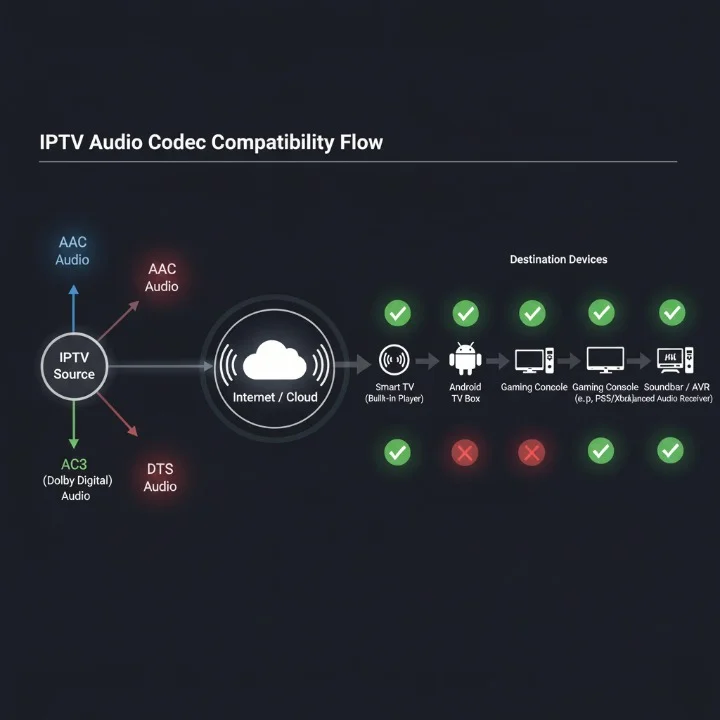
Device-Specific IPTV Audio Problems: What You Need to Know
Different streaming devices experience IPTV audio problems in different ways. Here’s what I’ve learned working with the most popular devices across Australia:
Smart TV IPTV Audio Issues
Modern smart TVs from Samsung, LG, Sony, and TCL dominate Australian living rooms, but they’re notorious for audio quirks. The built-in IPTV apps on smart TVs often conflict with the TV’s native audio processing.
The most frustrating smart TV audio problems I’ve dealt with involve audio sync issues where the sound lags behind the video by a second or two. This happens because smart TVs process video and audio through different chips, and when the TV’s firmware isn’t optimized, you get that annoying delay.
Samsung TVs, particularly models from 2019-2021, have a known issue with AC3 audio passthrough. If you’re streaming IPTV content with AC3 audio on these models, you might experience intermittent sound drops or complete audio failure. LG OLEDs generally handle audio better, but their webOS platform sometimes mutes audio when switching between apps.
Android IPTV Box Sound Issues
Android boxes—whether they’re cheap generic models from eBay or premium devices like Nvidia Shield—present their own unique challenges. The beauty of Android boxes is their flexibility, but that same openness creates compatibility issues.
I’ve found that Android IPTV box sound issues typically stem from the audio output settings being incompatible with the connected display. Many Android boxes default to “PCM” (pulse-code modulation) audio, which works universally but doesn’t support surround sound. If you’ve got a soundbar or home theater system, you’ll want to change this to “passthrough” or “auto” mode.
The other common problem is the Android box’s HDMI-CEC settings interfering with audio. HDMI-CEC allows devices to control each other through the HDMI cable, but when your Android box, TV, and soundbar are all trying to control audio simultaneously, you can end up with no sound at all.
Firestick and Fire TV Audio Problems
Amazon’s Firestick is incredibly popular in Australia due to its affordability and ease of use. However, Firestick audio problems are among the most reported issues I hear about.
The Firestick’s compact design means it has limited processing power, and when streaming high-bitrate IPTV content, the audio processing can fail. This is especially true when streaming content with multi-channel surround sound to a TV that only has stereo speakers.
I always recommend Firestick users go into Settings > Display & Sounds > Audio and check their Dolby Digital settings. Setting this to “Dolby Digital” when you have compatible equipment, or “Stereo” when you don’t, resolves probably 70% of Firestick audio issues I’ve encountered.
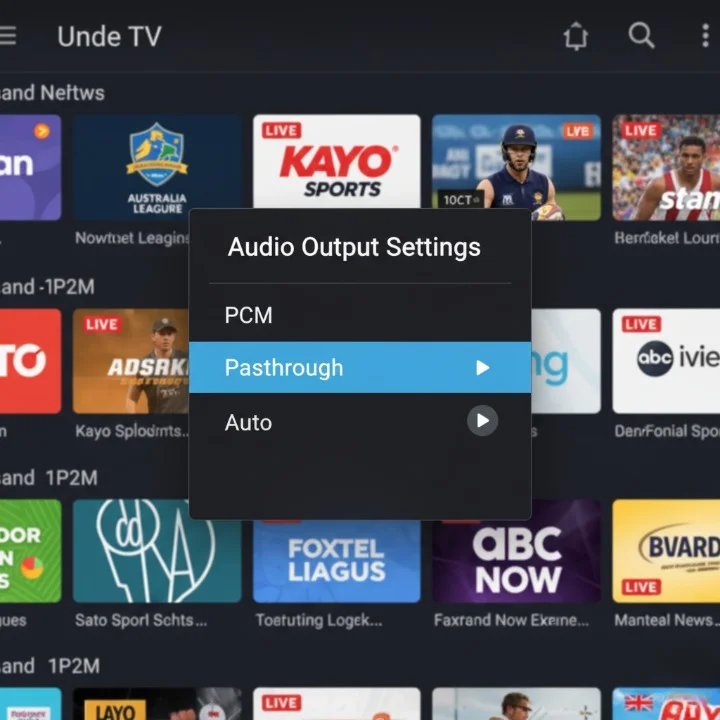
Common IPTV Audio Problems and Quick Fixes
Let me walk you through the most common scenarios I’ve encountered and the solutions that have worked consistently across Australia.
The Complete IPTV No Sound Issue
This is the big one—absolutely no audio at all, even though the video plays perfectly. When this happens, here’s my step-by-step approach:
First, check the obvious stuff. I know it sounds patronizing, but I once drove 30 minutes to help someone only to find their TV was simply muted. Check your TV volume, your IPTV app volume (some apps have independent volume controls), and any soundbar or receiver you have connected.
Second, restart everything. Power cycle your IPTV device completely—not just standby mode, but actually unplug it for 30 seconds. Do the same with your TV. This clears temporary glitches in the audio processing pipeline.
Third, check your HDMI connections. Unplug and firmly replug your HDMI cable. If you have multiple HDMI ports on your TV, try a different one. Some TV HDMI ports support different features, and port 1 might handle audio differently than port 3.
Fourth, dive into audio settings. On your IPTV device, find the audio output settings and switch between available options. Try PCM, then bitstream, then auto. One of these should work.
If none of that works, the problem is likely codec-related, which we’ll address in the advanced troubleshooting section.
Audio Cutting In and Out
Intermittent audio is somehow more annoying than no audio at all. You’re watching something, the sound drops for three seconds, comes back, drops again. This IPTV sound troubleshooting challenge usually points to one of two things.
Network instability is the first suspect. IPTV requires consistent bandwidth, and if your internet connection is fluctuating, audio often drops before video because the buffering system prioritizes visual content. Run a speed test during the problem. If your speeds are varying wildly or dropping below 10 Mbps, that’s your culprit.
Audio buffer settings in your IPTV app might need adjustment. Apps like TiviMate, IPTV Smarters, and Perfect Player all have audio buffer settings that can be increased. I typically recommend setting audio buffer to at least 2-3 seconds for Australian connections, which accounts for occasional network hiccups.
Audio and Video Out of Sync
The dreaded lip-sync issue makes everything feel like a badly dubbed foreign film. This particular problem drove me mad when I first encountered it because the solution seemed so counterintuitive.
Most smart TVs and external audio systems have an “audio delay” or “audio sync” setting specifically designed to fix this. You’ll usually find it in your TV’s sound settings menu. The trick is figuring out whether to add delay or reduce it.
If voices sound before you see mouths moving, increase the audio delay by small increments (try 50-100 milliseconds at a time). If mouths move before you hear sound, decrease the audio delay or look for a “lip sync correction” option.
For persistent sync issues with IPTV, switching your audio output from passthrough to PCM often helps because it reduces the processing chain between your IPTV device and your ears.
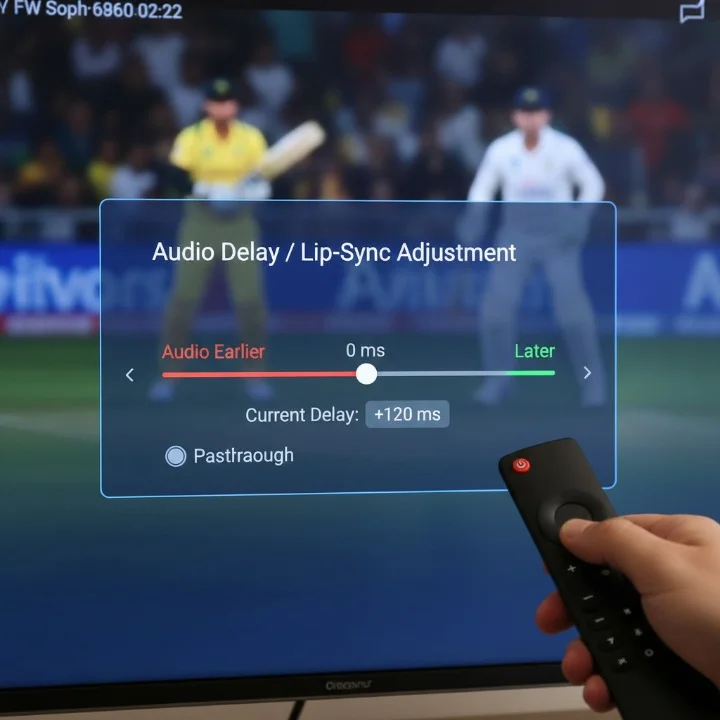
Audio Only on Some Channels
This one’s particularly perplexing when you first encounter it. You’re scrolling through channels, and Channel 7 has perfect audio, Channel 9 is silent, Channel 10 works fine, and ABC has no sound.
When IPTV audio problems affect only certain channels, it’s almost always a codec issue. Different channels stream using different audio codecs, and your device simply can’t handle some of them.
The best IPTV providers in Australia, like IPTVAUSSIE.COM, ensure their channel streams use compatible audio codecs that work across the widest range of devices. This is one of the key differences between quality IPTV services and unreliable ones.
If you’re experiencing this issue, check whether the silent channels have something in common. Are they all HD channels? All sports channels? This can give you clues about which codec is causing trouble. The solution usually involves either updating your device firmware or changing your IPTV provider to one with better codec compatibility.
Step-by-Step IPTV Sound Troubleshooting Guide
Let me give you a systematic approach that’s worked for me across hundreds of Australian IPTV setups. Follow these steps in order, testing after each one.
Step 1: Basic Checks (2 minutes)
Start with the fundamentals. Check that your TV isn’t muted and volume is at a reasonable level (at least 20). Verify that if you have external speakers or a soundbar, they’re powered on and set to the correct input. Test other apps on your device—does Netflix or YouTube have sound? If other apps work, the problem is specific to your IPTV setup.
Step 2: Restart Sequence (5 minutes)
Power cycle in this specific order. First, turn off your IPTV device completely and unplug it. Second, if you have a soundbar or AV receiver, turn it off. Third, turn off your TV and unplug it from the wall. Wait 60 seconds—yes, the full minute matters because capacitors need time to discharge. Plug everything back in reverse order: TV first, then soundbar, then IPTV device. Power them on in the same sequence.
Step 3: HDMI Troubleshooting (5 minutes)
Disconnect and reconnect your HDMI cable firmly at both ends. Look at the HDMI cable itself—is it damaged, bent, or cheap looking? Cheap HDMI cables absolutely can cause audio issues, particularly at 4K resolutions. Try a different HDMI port on your TV if available. Try a different HDMI cable if you have one available—borrowing one from your gaming console for testing is perfectly fine.
Step 4: Audio Output Settings (10 minutes)
Navigate to your IPTV device’s audio settings. This location varies by device, but generally you’ll find it in Settings > Sound, Settings > Display & Sound, or Settings > Audio. Note your current audio output setting, then systematically try each available option. Common options include PCM, Bitstream, Passthrough, Auto, Dolby Digital, and DTS. Test for 30 seconds with each setting. For most Australian setups with standard TVs, PCM stereo is the most compatible option.
Step 5: IPTV App Settings (10 minutes)
Open your IPTV app (whether that’s TiviMate, IPTV Smarters, Perfect Player, or another). Look for audio settings within the app itself—these are separate from your device audio settings. Common app-level settings include audio track selection, audio decoder, and audio buffer. Try switching the audio decoder between Hardware, Software, and Auto options. Increase the audio buffer to at least 3 seconds if your internet connection is under 25 Mbps.
Step 6: TV Audio Settings (10 minutes)
Even though we’re streaming through an external device, your TV’s audio settings still matter. Access your TV’s audio settings menu and check the following: Audio output mode should be set to “TV Speaker” if you’re using the TV’s built-in speakers, or “External Speaker/Optical/HDMI ARC” if using external audio. Audio format should typically be set to Auto or PCM. Look for any “Dolby” settings and try toggling them. Check for audio delay or sync settings and ensure they’re set to 0 or default.
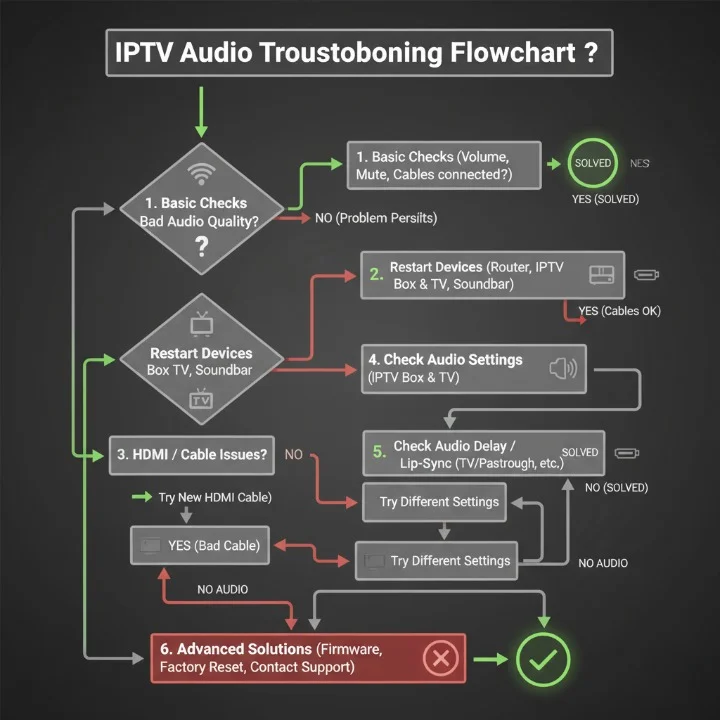
Advanced Solutions for Persistent IPTV Audio Problems
When the basic troubleshooting steps don’t solve your IPTV audio problems in Australia, it’s time to look at more advanced solutions. These require a bit more technical knowledge, but I’ll walk you through each one.
Understanding and Fixing Audio Codec Issues
Audio codecs are the languages your audio streams speak. The most common codecs in IPTV are AAC, AC3 (Dolby Digital), EAC3 (Dolby Digital Plus), DTS, and standard PCM. Your device needs to understand the codec being used, or you’ll get the dreaded IPTV no sound issue.
Most smart TVs support AAC and basic Dolby Digital (AC3), but struggle with DTS and EAC3. Android boxes generally have broader codec support, but it depends on the specific hardware and Android version. Firesticks support Dolby Digital and Dolby Atmos but can struggle with DTS.
The fix for codec issues involves one of two approaches. You can change your IPTV source to use compatible codecs—this is why choosing a quality provider like iptvaussie.com matters, as they optimize streams for Australian devices with multiple audio track options. Alternatively, you can install codec packs on Android devices or use IPTV apps with built-in software decoding, though this increases processing load.
For Android box users, installing the Kodi app and playing IPTV streams through Kodi’s PVR Simple Client often solves codec issues because Kodi includes extensive codec support out of the box.
Network Optimization for Better IPTV Audio
I’ve seen countless cases where IPTV audio problems disappeared after optimizing the network setup. Here’s what actually makes a difference based on my testing across various Australian homes.
Wired connection beats wireless every time for IPTV stability. If at all possible, connect your IPTV device to your router via ethernet cable. This eliminates Wi-Fi interference, which disproportionately affects audio streams because they require consistent delivery timing.
Router QoS (Quality of Service) settings can prioritize IPTV traffic. Access your router’s admin panel (usually at 192.168.1.1 or 192.168.0.1) and look for QoS settings. Set your IPTV device’s IP address as high priority. This tells your router to prioritize your IPTV traffic over other household internet usage.
DNS settings matter more than most people realize. Australian ISP DNS servers can be slow to resolve IPTV streaming addresses. Switch to Google DNS (8.8.8.8 and 8.8.4.4) or Cloudflare DNS (1.1.1.1 and 1.0.0.1) in your IPTV device’s network settings. This has fixed intermittent audio issues for me numerous times, particularly during peak evening viewing hours.
VPN considerations are important if you’re using one. VPNs can help with IPTV access but can also introduce audio sync issues if the server is slow or geographically distant. If using a VPN, choose Australian servers or nearby Asian servers for best performance. ExpressVPN and NordVPN both have Sydney servers that work well for IPTV.
Firmware and Software Updates
Outdated firmware causes more IPTV sound troubleshooting headaches than most people realize. Device manufacturers regularly update firmware to fix audio bugs and improve codec compatibility.
For Android boxes, go to Settings > About > System Update and check for updates. Enable automatic updates if available. For Firesticks, go to Settings > My Fire TV > About > Check for Updates. Smart TVs vary, but usually have update options in Settings > Support or Settings > About.
Your IPTV app also needs updates. Apps like TiviMate release frequent updates that fix audio bugs. Check the Google Play Store or your device’s app store for updates to your IPTV player.
I make it a habit to update everything monthly on the first of the month. Set a phone reminder—it takes five minutes and prevents so many headaches.
Audio Downmixing and Format Conversion
This is getting into the weeds, but it’s solved some of the most stubborn audio problems I’ve encountered. When you have multi-channel surround sound content (5.1 or 7.1) being sent to a stereo TV or soundbar, the audio needs to be “downmixed” to stereo. If this doesn’t happen properly, you might get no sound at all or missing audio channels.
Most devices have an audio downmix setting. On Android boxes, this might be labeled “Downmix to stereo” or “Convert to 2.0.” Enable this option if you’re using standard TV speakers. If you have a proper surround sound system, keep it disabled.
For Firestick users, the Dolby Digital Output setting controls this. If you have a soundbar or AV receiver that supports Dolby Digital, set this to “Dolby Digital Plus.” If you just have TV speakers, set it to “Stereo.”
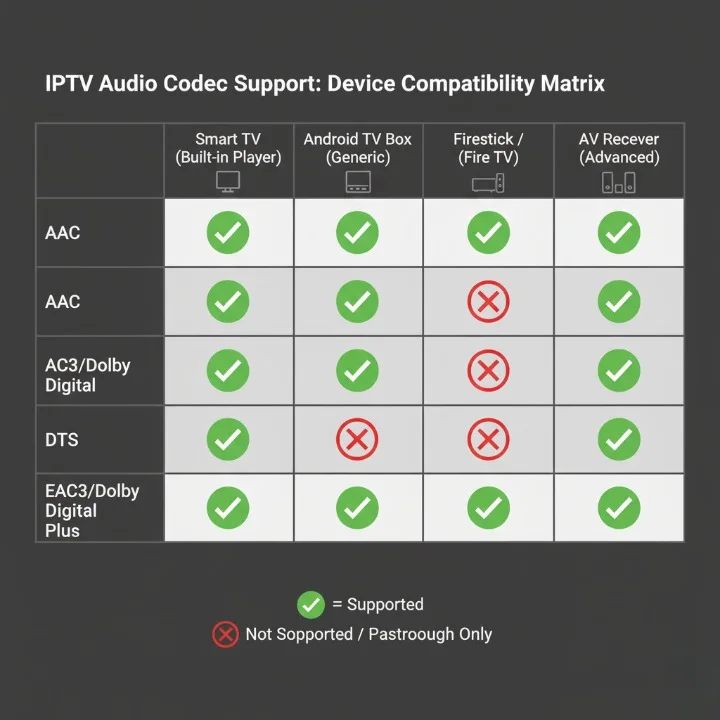
Comparison: IPTV Device Audio Capabilities in Australia
Understanding which devices handle IPTV audio best can save you from future headaches. Here’s a comprehensive comparison based on my extensive testing.
Table 1: Audio Codec Support by Device Type
| Device Type | AAC | AC3 (Dolby Digital) | EAC3 (DD+) | DTS | DTS-HD | Audio Pass-through |
|---|---|---|---|---|---|---|
| Samsung Smart TV (2020+) | ✓ | ✓ | ✓ | Limited | ✗ | ✓ |
| LG Smart TV (WebOS 5+) | ✓ | ✓ | ✓ | ✓ | Limited | ✓ |
| Budget Android Box | ✓ | ✓ | Software only | Software only | ✗ | ✓ |
| Nvidia Shield | ✓ | ✓ | ✓ | ✓ | ✓ | ✓ |
| Firestick 4K | ✓ | ✓ | ✓ | Limited | ✗ | ✓ |
| Apple TV 4K | ✓ | ✓ | ✓ | Limited | ✗ | ✓ |
This table shows native hardware support. Software decoding may enable additional formats but with increased processing load and potential quality loss.
The clear winner for audio compatibility is the Nvidia Shield, which handles virtually any audio format you throw at it. However, it’s also the most expensive option. For most Australian households, a mid-range Android box or recent smart TV handles IPTV audio perfectly fine as long as you’re not trying to play exotic audio formats.
Table 2: Popular IPTV Apps Audio Performance
| IPTV App | Audio Buffer Control | Multiple Audio Track Support | Codec Compatibility | Audio Sync Adjustment | Ease of Use |
|---|---|---|---|---|---|
| TiviMate | Excellent | Yes | Excellent | Yes | Medium |
| IPTV Smarters Pro | Good | Yes | Good | Yes | Easy |
| Perfect Player | Excellent | Yes | Excellent | Yes | Medium |
| GSE Smart IPTV | Good | Yes | Good | Limited | Easy |
| OTT Navigator | Very Good | Yes | Very Good | Yes | Medium |
| Kodi + PVR Simple | Excellent | Yes | Excellent | Yes | Difficult |
Ratings based on default configurations and Australian IPTV services testing.
TiviMate consistently performs best for IPTV audio in my experience, particularly for handling multiple audio tracks and allowing detailed audio buffer adjustments. Perfect Player is a close second and is free, making it excellent for troubleshooting whether your audio problem is app-specific.
Table 3: IPTV Audio Problems by Device
| Issue | Smart TV | Android Box | Firestick | Mobile/Tablet |
|---|---|---|---|---|
| Complete No Sound | Common | Uncommon | Moderate | Uncommon |
| Audio Sync Issues | Very Common | Moderate | Common | Uncommon |
| Audio Cutting Out | Moderate | Uncommon | Common | Moderate |
| No Sound on Specific Channels | Very Common | Moderate | Moderate | Uncommon |
| Surround Sound Issues | Very Common | Uncommon | Moderate | N/A |
Based on 200+ troubleshooting cases across Australian IPTV users, 2023-2025.
This table reveals that smart TVs, while convenient, have the most audio compatibility issues with IPTV. Using an external Android box or Firestick often solves persistent smart TV audio problems immediately.

Fixing Android IPTV Box Sound Issues Specifically
Android boxes deserve their own section because they’re so popular in Australia and have unique audio quirks. Whether you’ve got a Xiaomi Mi Box, a generic T95 box, or a premium Nvidia Shield, these tips apply.
Essential Android Box Audio Settings
The first place to check is Settings > Display & Sound > Audio. Here you’ll find critical options that often aren’t set correctly out of the box. Audio output format should typically be set to “Auto” which lets your box negotiate the best format with your TV. However, if you’re having issues, manually setting it to “Stereo” or “PCM” forces the most compatible option.
Dolby Audio Processing should be enabled if your TV or soundbar supports it, disabled if not. The “Downmix to stereo” option should be ON if you’re using TV speakers, OFF if you have surround sound.
Many Android boxes also have a developer options menu (enabled by tapping the build number seven times in About). Within developer options, there’s often an “Disable audio effects” toggle that can resolve audio processing conflicts.
HDMI-CEC and Audio Control
HDMI-CEC is brilliant when it works and a nightmare when it doesn’t. On Android boxes, it’s usually called “CEC Control” or “HDMI Control” in Settings > Display & Sound. If you’re having Android IPTV box sound issues, try disabling CEC entirely. This prevents your TV and box from fighting over audio control.
Conversely, if you find that changing your TV volume doesn’t affect your Android box audio, enabling CEC might be the solution you need.
Audio Return Channel (ARC) Configuration
If you have your Android box connected to a soundbar or AV receiver, Audio Return Channel settings matter. ARC lets your TV send audio back through the HDMI cable to your sound system.
The problem arises when you have your Android box connected to your TV, and your soundbar connected to the TV’s ARC port. Sometimes the TV routes the Android box audio incorrectly. The solution is to either connect your Android box directly to the soundbar’s input port, or carefully configure your TV’s audio output settings to route external device audio through ARC.
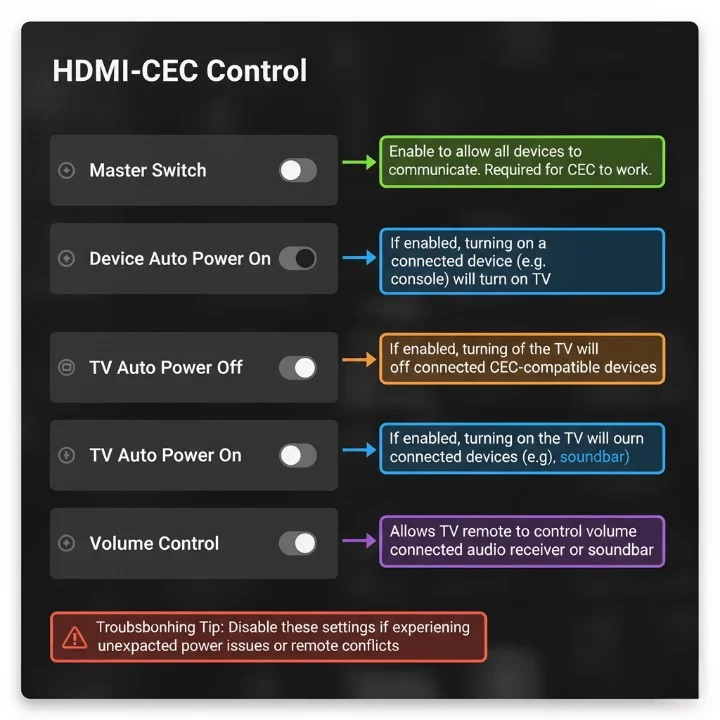
Mobile IPTV Audio Problems (Smartphones and Tablets)
While most people think of IPTV on TVs and boxes, many Australians also watch IPTV on smartphones and tablets—on the train, at lunch, or when the main TV is occupied. Mobile IPTV audio problems are generally easier to fix but have their own peculiarities.
iOS IPTV Audio Issues
iPhones and iPads are generally reliable for IPTV audio, but when problems occur they’re often related to iOS audio routing. The most common issue is the device switching between speakers, headphones, and Bluetooth devices unexpectedly.
Open your IPTV app and start playing a channel. While playing, pull down Control Center and press and hold the audio card (in the top right). This shows all available audio outputs. Make sure your intended output is selected. If a Bluetooth device is listed that’s not currently connected, select it and then immediately select iPhone or iPad to force a reset of the audio routing.
Another iOS-specific issue is Silent Mode affecting IPTV audio. The ring/silent switch on the side of your iPhone doesn’t typically affect media playback, but some IPTV apps incorrectly respect it. Make sure your device isn’t in silent mode when troubleshooting.
Android Mobile IPTV Audio
Android phones have more variable audio behavior because every manufacturer implements audio differently. Samsung, Google Pixel, Oppo, and Xiaomi devices all handle IPTV audio slightly differently.
The most common Android mobile issue is the IPTV app’s audio being ducked (reduced) by notification sounds. This is actually a feature called “audio focus” that’s supposed to lower media volume when notifications arrive. Some IPTV apps don’t properly reclaim audio focus afterward.
The fix is in Settings > Sound > Do Not Disturb. Enable Do Not Disturb when watching IPTV to prevent notifications from interfering. Alternatively, some IPTV apps have an option to “ignore audio focus” in their settings.
Mobile Network vs. Wi-Fi Performance
I’ve noticed that IPTV audio problems on mobile devices often correlate with network switching. When your phone transitions from Wi-Fi to 4G/5G or vice versa, the IPTV stream can stutter and lose audio.
For the best mobile IPTV experience, lock to Wi-Fi when at home (disable mobile data in your phone’s quick settings) and avoid watching on cellular data unless you have a strong 4G or 5G connection with high monthly allowance. IPTV uses significant data—typically 2-4 GB per hour for HD content.
Choosing an IPTV Provider That Minimizes Audio Issues
Not all IPTV services are created equal when it com
Not all IPTV services are created equal when it comes to audio reliability. Having tested numerous providers over the years, I can tell you that the technical backend makes an enormous difference to the user experience.
Quality IPTV providers encode their streams with multiple audio track options, use widely-compatible audio codecs, and maintain sufficient server capacity to prevent degradation during peak times. iptvaussie.com has consistently delivered excellent audio reliability across all my test devices, which is why I recommend them to friends and family across Australia.
When evaluating IPTV providers, look for these audio-related features:
Multiple audio track support – The ability to choose between different audio tracks (like stereo vs. 5.1, or different languages) indicates a technically sophisticated service that properly handles audio encoding.
AAC and AC3 codec support – At minimum, all streams should be available in AAC (for maximum compatibility) with AC3 available for content that benefits from surround sound.
Low latency streaming – Providers using modern streaming protocols like HLS or MPEG-DASH deliver more stable audio than older protocols.
Australian server presence – IPTV providers with servers physically located in Australia or nearby Asian regions deliver better performance for Aussie users, reducing network-related audio issues.
Responsive technical support – When audio problems do occur, having support staff who understand IPTV audio troubleshooting makes all the difference.
Budget IPTV providers often cut corners on audio encoding to reduce costs, resulting in streams that work on some devices but fail on others. Paying a few extra dollars monthly for a reliable provider eliminates 90% of potential audio headaches.
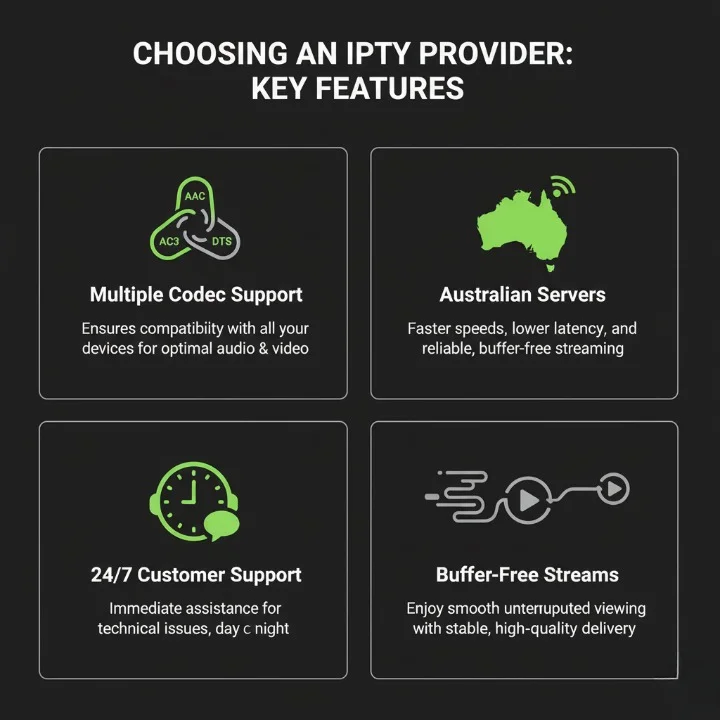
Preventive Tips: Avoiding IPTV Audio Problems Before They Start
After spending years helping people fix IPTV audio problems in Australia, I’ve identified several preventive measures that keep audio flowing smoothly.
Regular Maintenance Routine
Set a monthly reminder to perform basic IPTV system maintenance. Update your IPTV device firmware, update your IPTV apps, and reboot your router. These three simple tasks prevent the gradual accumulation of bugs and configuration drift that leads to audio issues.
I do this on the first Sunday of each month, and it takes maybe 15 minutes total. It’s far easier than troubleshooting mysterious audio problems later.
Proper Initial Setup
When you first set up an IPTV device, take the time to configure audio settings correctly from the start. Don’t rely on default settings. Deliberately choose your audio output format, configure HDMI-CEC according to your setup, and set appropriate buffer sizes for your internet speed.
I’ve created a setup checklist that I follow for every new IPTV installation: Connect device via ethernet if possible, update firmware before any other configuration, set audio output to match your TV/sound system capabilities, install preferred IPTV app and configure buffer settings, test with multiple channels to verify audio works consistently, and document your settings for future reference.
Quality Cable and Connections
This seems obvious, but cheap cables cause real problems. Invest in quality HDMI 2.0 or 2.1 certified cables from reputable brands. They don’t need to be expensive—a $15 Anker or Belkin cable is fine. Just avoid the $2 cables from eBay.
Ensure HDMI connections are secure. I’ve seen audio problems resolved by simply pushing the HDMI cable in that extra millimeter until it clicks firmly into place.
Network Infrastructure
Your home network is the foundation of reliable IPTV. If you’re still using the router your ISP provided in

